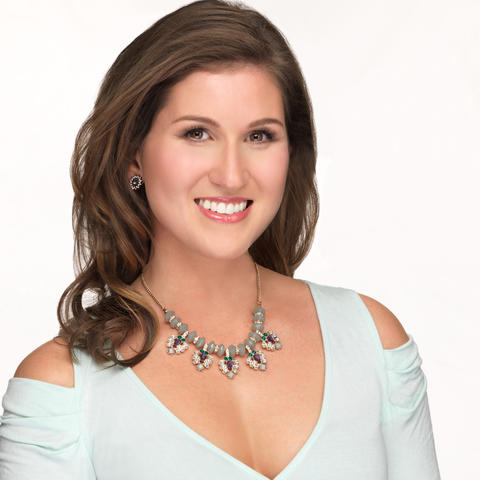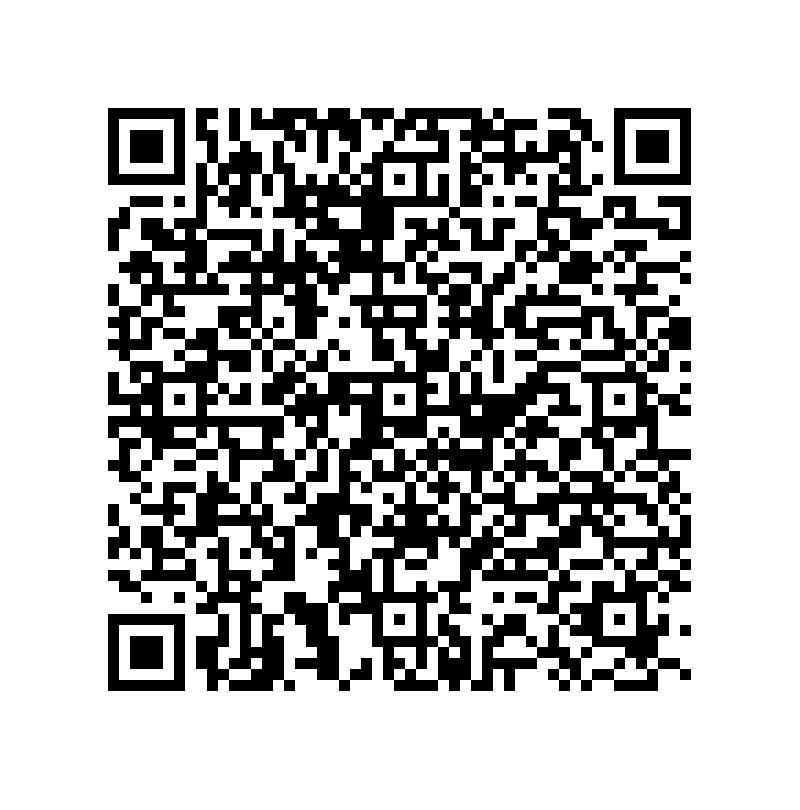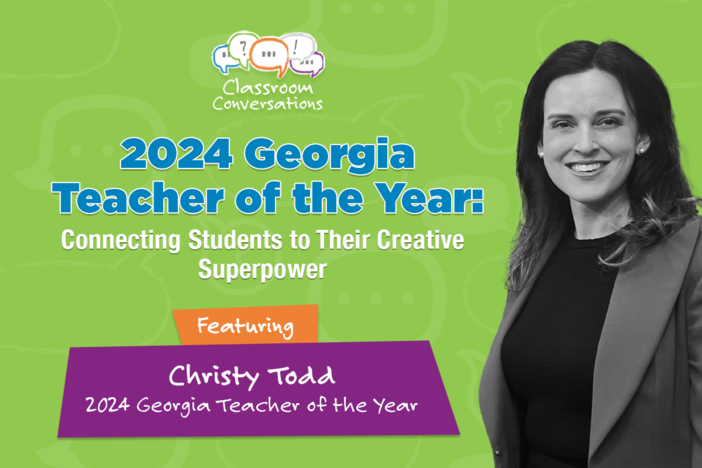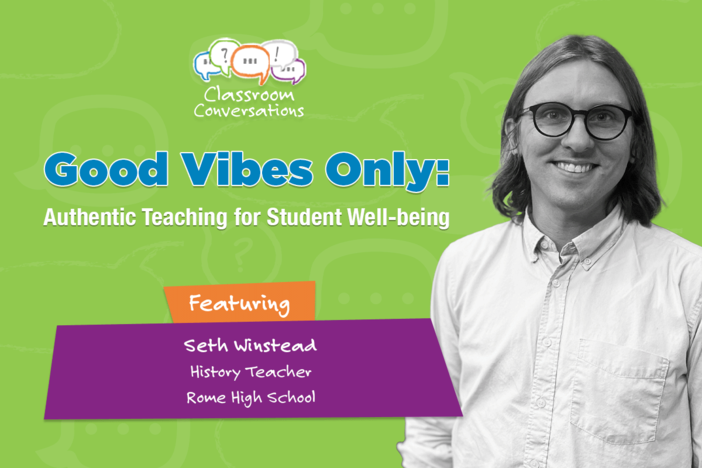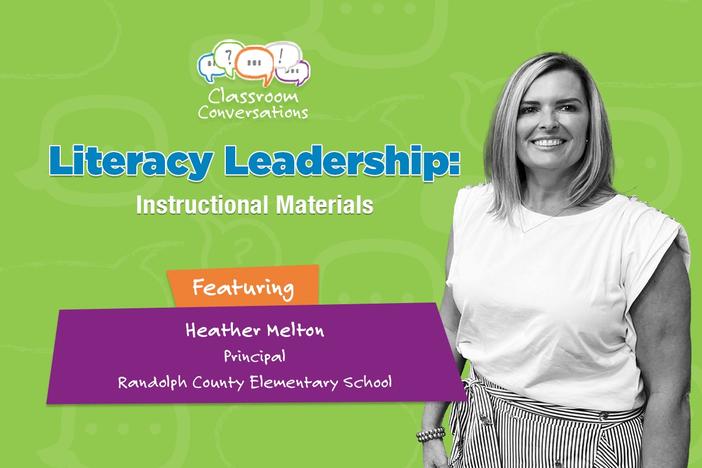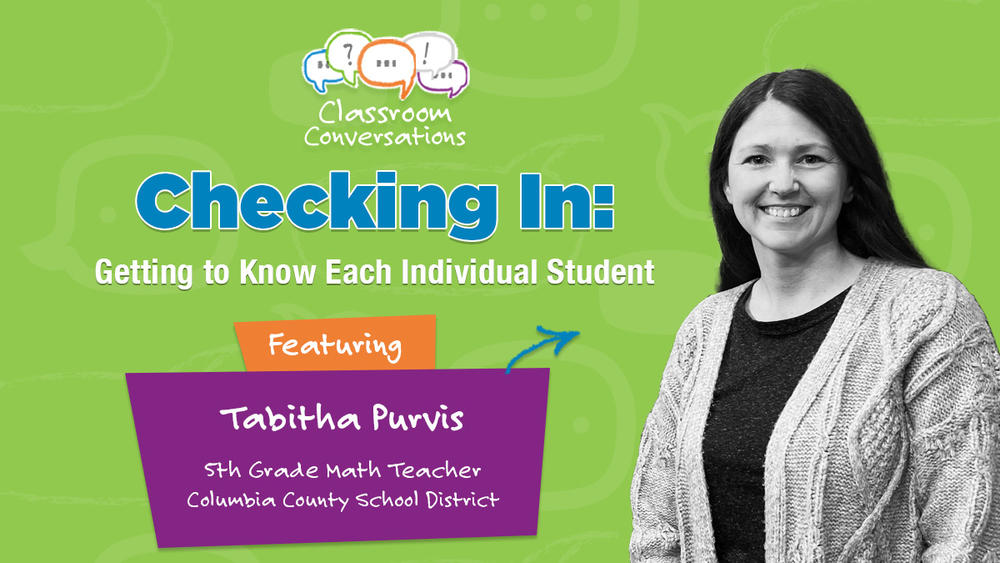
Section Branding
Header Content
Episode 308: Checking In: Getting To Know Each Individual Student
Primary Content
Knowing each individual student can make a profound difference in student success. This task can also be a challenge. Join us in conversation with Tabitha Purvis of Columbia County Schools for tips on getting to know all of your students.

Click here to view the discussion guide!
Knowing each individual student can make a profound difference in student success. This task can also be a challenge. Join us in conversation with Tabitha Purvis of Columbia County Schools for tips on getting to know all of your students.
TRANSCRIPT
Ashley Mengwasser: Hey, Georgia educators, we have new discussion guides available to use with Classroom Conversations episodes. These discussion guides include open-ended questions to facilitate great discussion and professional learning after listening to each podcast. Find the new discussion guides posted with the Classroom Conversations episodes and blogs in Georgia Home Classroom. Good day, Georgia educators. You know me, it's host, Ashley Mengwasser, and this is Classroom Conversations, the platform for Georgia's teachers. Weekly, we bring you to a place where, for a half hour, you can share and learn. How about that? It's compliments of a partnership between two education powerhouses, the Georgia Department of Education and Georgia Public Broadcasting. Well, hi, how do you feel today? What is your intention for today? What do you think is the biggest change since yesterday? Oh, and what are you most looking forward to? Okay, Ash, why the barrage of questions? Oh, I'm just checking in with you. Maybe that was too much. As usual, I'm electrified by the subject matter. The practice driving today's episode is actually checking in with students to support the whole child. It's an, 'I see you' to help bring young learners to the table for instruction. I'm a city girl and our teacher guest, well, she's not. She's a self-proclaimed nerd who hails from Euchee Creek Elementary in Columbia County School District. She's a fifth grade mathematics teacher who maths all day, and she's been at this teaching thing for 17 years now. We welcome in the classroom purview of Tabitha Purvis. Tabitha 100% has tabs on her students. You'll hear how. Hey, Tabitha.
Tabitha Purvis: Hey.
Ashley Mengwasser: Welcome to the big city.
Tabitha Purvis: Well, it's good to be here.
Ashley Mengwasser: You were telling me the things you passed en route to our studio. Describe for our audience.
Tabitha Purvis: Well, it was cars and buildings, and I'm used to cows and horses and stop signs.
Ashley Mengwasser: What was that like?
Tabitha Purvis: It was, "Okay, what am I getting into? This is a little out of my league."
Ashley Mengwasser: And then you arrived here.
Tabitha Purvis: Yeah.
Ashley Mengwasser: With some microphones, and we're in a padded room, but it's for your safety.
Tabitha Purvis: I need that.
Ashley Mengwasser: It's just acoustics paneling, don't worry. How did you decide to teach way back when?
Tabitha Purvis: Well, back, I was a little kid, I was in second grade, and if you remember Weekly Readers, I remember reading one and they talked about how teachers were that as a profession and a career, and it's the first time I'd ever really thought about, "Hey, I could be a teacher, these people choose to be teachers." And so, since second grade, I had this idea that teaching was going to be for me.
Ashley Mengwasser: And you knew since second grade?
Tabitha Purvis: Yeah. It didn't really change much. My sister wrote a lot of book reports when she was eight-
Ashley Mengwasser: Okay.
Tabitha Purvis: ...9, 10.
Ashley Mengwasser: So, it panned out.
Tabitha Purvis: It did, it worked out well.
Ashley Mengwasser: And here you are now.
Tabitha Purvis: Yeah.
Ashley Mengwasser: At Euchee Creek, which is in Grovetown. What's fun about Grovetown? Tell us about it.
Tabitha Purvis: So, Grovetown is just this small town that's growing bigger every day. So you can drive one direction and be in the middle of nothing, and drive the other direction and have everything you want to purchase ever. So it's just a great location in the middle where you have access to both worlds.
Ashley Mengwasser: That sounds perfect for you too.
Tabitha Purvis: Perfect.
Ashley Mengwasser: Civilization away from civilization.
Tabitha Purvis: Perfect for me.
Ashley Mengwasser: And I know me you like to spend more time in the away. You do a lot of family activities. Tell us about those.
Tabitha Purvis: I love to go camping, as much as my husband will take off from work and go with me, let's go. And we like to travel and just take the kids to go and see and do and have experiences. The nerd in me wants to take them to Williamsburg and then Mesa Verde and everywhere that they can learn. And everybody else is going to the beach, and I'm not dragging my kids there, I'm off trying to teach them something else.
Ashley Mengwasser: That's more exciting, I think. Well, bless the nerd in you.
Tabitha Purvis: Yes.
Ashley Mengwasser: And these two kids you've got are 7 and 11.
Tabitha Purvis: They are.
Ashley Mengwasser: And one used to be your student.
Tabitha Purvis: She was my student, still is a little bit. It was the best experience.
Ashley Mengwasser: What was that like, teaching your daughter?
Tabitha Purvis: I was nervous about it at first because I didn't really know how it would go. But as the year progressed, she just was able to help me be a better teacher. And she was brilliant at math already, so I could really step up my game for helping us hire kids while she was like, "Okay, mom, this isn't really working." And she was able to perfect my art as well.
Ashley Mengwasser: She was. And what did she call you in the classroom?
Tabitha Purvis: Well, she-
Ashley Mengwasser: "Hey, mom."
Tabitha Purvis: ... would refuse to call me mom. So it was a lot of, "Miss Purvis, this and that." So even at the house, emptying in the dishwasher, doing her chores, it was, "Hey, Miss Purvis." And then she had to step back and laugh a little bit. It was a fun time, fun time.
Ashley Mengwasser: When was that? When did you teach her?
Tabitha Purvis: Last year.
Ashley Mengwasser: Last year.
Tabitha Purvis: Still fresh.
Ashley Mengwasser: So, you could potentially teach your youngest someday?
Tabitha Purvis: That might happen.
Ashley Mengwasser: Might happen.
Tabitha Purvis: We'll see.
Ashley Mengwasser: Okay. Well, I know that there's an important icon in your classroom that you use to motivate. It's an organ. Which one is it?
Tabitha Purvis: It's the brain.
Ashley Mengwasser: Tell us about that.
Tabitha Purvis: Well, I have this idea that you want kids to feel like you see them and that they have a purpose for being there. And if you tell them you're there to be their teacher, they're like, "Well, so is everybody else." So I start the year with, "No, you have a brain and I want your brain to make decisions and to decide to go places and to have a job that can pay for all these things you want and things you want to see and just experiences you want to have yourself." So we really start the year thinking about what they want and how I can help them achieve that, so that we can really direct the focus of our classroom.
Ashley Mengwasser: So, you say to them all the time, "Look, we're building your brain."
Tabitha Purvis: Building our brains.
Ashley Mengwasser: Which sets the tone for everything you do. It's the rhetorical "Why" you don't have to answer, because the answer to everything you do in your classroom is, "We're building your brains."
Tabitha Purvis: And it's very selfless on my part because it puts the responsibility back on them. "Hey, it's your brain and you're going to have to do something one day with it. It's your paycheck."
Ashley Mengwasser: Right.
Tabitha Purvis: "What do you want to be able to afford to do? How can I help you to afford those things by helping build your brain?" And it is tremendous how much buy-in I can get with that.
Ashley Mengwasser: Because you're giving them empowerment and responsibility from a young age, which kids actually like, believe it or not.
Tabitha Purvis: They do.
Ashley Mengwasser: Checking in with students is our topic today, and I was thinking of some ways that we might check in with people just in general. Remember the old, "What's up?" Remember that?
Tabitha Purvis: Right.
Ashley Mengwasser: That is almost offensive to ask people now. If you ask somebody, "What's up?" They're like, "What? What am I supposed to be doing?" That has changed.
Tabitha Purvis: It has.
Ashley Mengwasser: And so, I imagine that there are fruitful ways to check in with students, just like adults, and not so fruitful ways, so I look forward to hearing about that from you during this episode, Tabitha. Why is it important for teachers to be aware of their students emotional and physical wellbeing, and provide support for that piece of them?
Tabitha Purvis: Okay. Well, I think we enter the teaching career with this idea that, "Okay, we're ready to be teachers and these kids are going to come in ready to be students, and they're just going to soak up everything we give to them." But the reality is, they come in and their brains are already pretty full with stuff. Sometimes, it's baggage and problems and worries, but often it's jokes and funny stories and just what happened last night, they just want us to know. And if we can give them a time and an appropriate way to share that, it takes it off of their plate. It empties their brain a little bit so I can fill it up with the things that I've got for our plan for the day.
Ashley Mengwasser: That's beautiful. So you're giving them a space where they can impart that, share that rapport build among themselves, before you dive into the instruction.
Tabitha Purvis: Right.
Ashley Mengwasser: And so then, you say that just carving out that time is worth it.
Tabitha Purvis: Right.
Ashley Mengwasser: How much time are we talking here?
Tabitha Purvis: And that's the thing that I feel like teachers need to give themselves some grace on, because when it comes across in a professional development, it seems like, to be done correctly, it needs to take hours and hours and hours of your time to prepare and have ready. But the reality is, it's just the relationship, the questions that you're asking and the time that you listen. So finding really quick ways to have that touch base with them, that's what's important. It's not really how long you spend, it's just the frequency that you do it, and so it can be really quick.
Ashley Mengwasser: Right. Making it a habit in the classroom.
Tabitha Purvis: Right.
Ashley Mengwasser: And we're just talking about how important it seems to be to connect with students, more now than ever before. What are some of those ways that you check in with students?
Tabitha Purvis: Okay. So I think just keeping in mind, checking in with the student sets the tone of your classroom. Having those morning meetings with them, having that stand at the door, "Hey, what's going on?" As they're coming in. "How are you feeling?" But having them write it down takes it to a whole ‘nother level. So those are some of the biggest things that I do, because if they write it down and they know that you're hanging onto it, you want to look at it later, it's that valuable to you, those are the things that I find that give them the most buy-in to you and to your classroom. And that seems to be a way for them to want to release that information to you.
Ashley Mengwasser: How do you ask them to write about it?
Tabitha Purvis: So, I use a lot of sticky notes. I like for it to be personal. A lot of people will do a feelings chart, but to me that just feels very generic for everybody. But if I pick out a specific color sticky note as they're walking in or as I'm doing something, and I hand them, "Oh, I picked this color out for you." Share with them what you're doing, "How's it going? What do you want to accomplish today?" If they will write those things down, and then I take those things and put them in a folder, each kid has their own folder, so that way they know, "Hey, this information is precious to me." I might not have time to respond to it right now, but they know I'm not just going to let it go. I'm going to keep coming back to it. And then, as a teacher, you get busy, when you do take a minute and think, "Hold on, what was going on with that kid?" You have that resource to go back to and say, "Hey, what did that kid write down?" And when I look at three or four notes together, "What is it they're trying to tell me?"
Ashley Mengwasser: Ah, there's a story sometimes there.
Tabitha Purvis: Mm-hmm.
Ashley Mengwasser: Yeah. And does it feel for them like they're receiving support? How do you notice that this is supporting them?
Tabitha Purvis: So, they notice that I keep up with it. They notice that I have a place that I stick it. They notice that it doesn't just get lost in the madness of the classroom. So because they notice that I'm taking that time out for them, it literally comes across as if I'm taking time out for them. So even though I don't have 20 minutes to spend every single day checking in, it feels like 20 minutes to each kid, because it's a piece that I can come back to every couple of days with them and say, "Hey, I noticed you wrote this," or, "You have cheerleading going on," or, "You got a new fish, so tell me about how this fish is doing." It gives you that personal connection with them and they respond to that so well because they just have that big smile. But the more you tell them what you remember, the more they want to open up and share with you.
Ashley Mengwasser: You're building a bridge to each individual kid and it's not taking you much time. You're just using that information as you're leveraging it for the benefit of them and for the benefit of your classroom. Well, let's talk about what happens when you check in with students and you notice that there are some concerning things to deal with.
Tabitha Purvis: Yeah.
Ashley Mengwasser: I bet that happens from time to time.
Tabitha Purvis: Yeah. Sometimes you're giving them a sticky note and you're like, "All right, tell me what's going on, what you're going to accomplish today." And you think they're going to be like, "Everything's fine, and I want to learn how to multiply fractions and it's just going to be great." And then, you look at the sticky note and there's something a lot heavier on it. And you have to give yourself a little grace because at first, it's like, "Well, what do I say to this kid?" I don't know that anybody really has the right response to some of the situations that we get. But I find more often that if you develop that frequency of, "Hey, write it down. Let me see it. I want to hang onto it." For a lot of kids, it's not so much what they're carrying, it's the fact that they have to carry it by themselves. And so, for them to be able to share that information with me and then to be able to feel the release of, "Somebody else is helping me through it, somebody else is carrying this with me. It's not all on my shoulders."
Ashley Mengwasser: Right.
Tabitha Purvis: Sometimes that's just all that-
Ashley Mengwasser: It takes.
Tabitha Purvis: ... especially in elementary, that's what they need more than somebody to fix the problem. They just need to know that they're not in the problem by themselves.
Ashley Mengwasser: To help them carry it.
Tabitha Purvis: Mm-hmm.
Ashley Mengwasser: Just by knowing that that's going on, that's a beautiful thing. So then, how do home lives and parents intersect here? I'm sure you connect and check in with parents about students. How does that help you and parents work together to support each child?
Tabitha Purvis: Well, I feel like the parents are a significant part of what we're doing because we are their parents during the day, and we have to have that family going on. And you'd never want to call a parent halfway through the year and it be the first time you've ever spoke with them. So one thing I like to do is take a sheet of paper, put a bunch of squares on it, think about a grid, and each kid gets their own square. So as they share things with me, things that are memorable, things that come up, things that they did really well on, I can jot it down in each square. So when I make that initial contact, or, "Man, it's been a couple of months since I've talked to this parent," when I reach out through maybe an email, a post-it notes, sticky notes, just anything that I can send home, maybe it's even a phone call, but sometimes those just take too long.
Ashley Mengwasser: Yeah.
Tabitha Purvis: Something very quick that I can just reach out to that parent, it can be very personal. So again, it doesn't have to take a lot of my time, but if I reference something that the kid has told me, something that's going on, even if it's just, "Hey, this is the joke your kid's been telling me for a week now," the parent knows that I've invested in their child, so the parent has bought into my classroom. And then August, September, everything's walking and rolling, but then October, November rolls around and I might need a little more support, the parent's not entering my classroom for the first time now. The parent has been with us all along, they've been a part of this journey, and so they feel like they can actually support me wholeheartedly because they've been a part of it the whole time. It's not new to anybody in the situation. And then, the kids grow from it as well, because they know that we're all on the same page. So, I can just say, "Hey, how's mama going to feel about...?" And whatever the situation is, good or bad, the student always replies because they know that that communication does take place. And sometimes, it's a matter of just providing extra support to the parents. Once a week, I like to shoot out an email with just very simple websites that could help them, maybe some videos, online tutorials, online games that the kids would like. So fifth grade math, a lot of parents, they have a lot on their plate, so sometimes they're like, "I don't really know how to help with this." It really levels the playing field, so it makes them want to be a part as much as they choose to be, and it gives them those tools. So they can either offer the resource or they can sit down and help with the resource. It gives them tools so that they can become a part of our classroom as well.
Ashley Mengwasser: And you know how their child is doing with the certain learning task based on checking in with them.
Tabitha Purvis: Right.
Ashley Mengwasser: So, you're using that as a tool, even to help parents help support their children at home.
Tabitha Purvis: Right.
Ashley Mengwasser: And this day and age, I know... I don't know if, are you a text or phone call person, Tabitha?
Tabitha Purvis: I'm a bit of both.
Ashley Mengwasser: A bit of both? Yeah.
Tabitha Purvis: I'm a bit of both. If it's positive and it's easy to go, I think texting is definitely preferable. But if there's any chance that this is going to get lost in the words that I send, it's the phone call that's going to be personable here.
Ashley Mengwasser: Yeah. This day and age, I know there's a lot of preferences one way or the other. I'm a phone call person, I like to chat, but there definitely are times where it's more efficient to send a text. So to not have to pick up the phone and call every parent, which I imagine takes a lot of your time as well.
Tabitha Purvis: Right.
Ashley Mengwasser: If you can communicate with them with supportive resources or more of your sticky notes, which we know you love-
Tabitha Purvis: Right.
Ashley Mengwasser: ... then that's getting the job done. Well, I want to hear some anecdotes about how this really comes to life in the classroom. Would you share a time or two that you gave a student some insight that allowed you to support them as a whole?
Tabitha Purvis: Okay. So there was this one kid that will always stick out in my mind. He's as big as me, he does not mature as some of the other fifth graders are acting, but he's much larger than everybody else. And so, when he gets questions wrong and he's struggling with why he got it wrong and how to handle it, it gets kind of loud. And so, some teachers are going to come back loud or are going to come back with a strong discipline hand, where my technique is more of, let me walk over. Let me sit down because that's not what he expects. Let me write something on the paper and then just sit there with it, because he's going to look up to know, "What in the world did you just write?" And then, I'm able to hand it to him and just slip it across. Everybody else in the room's trying to figure out crazy teacher, "What's she doing now?"
Ashley Mengwasser: Yeah, what's going on over there?
Tabitha Purvis: Right. So the room is quiet at this point, but it's still a very, while it's a public situation because he made it public, it's still a very private interaction between us.
Ashley Mengwasser: Interesting.
Tabitha Purvis: And the first time, he just threw the paper off, and I wrote back, "Do you know why you're upset?" And he just shook his head no. And I think we need to give some respect to that, because sometimes we ask questions thinking the kids have words for answers, and they have answers, but they don't have the words. And so, being able to just say, "Hey, I love you and it's okay that you don't know how to explain how you feel. Sit here, we'll talk later. And if you want to write anything, you can." And then I just can walk back to the front of the room and start teaching. And that was just for that specific student. That was the beginnings of just one of my favorite relationships, because he knew that, at the end of the day, I cared about him. And even when he didn't really know how to respond, he knew it was still going to be okay and that... Instruction was going to happen, that was non-negotiable, and it developed where it didn't stop our instruction. And he just really came in as one of our top academic performers that year.
Ashley Mengwasser: Wow. What a turnaround.
Tabitha Purvis: He bought into the classroom, and he learned how to push those, I don't want to say push the feelings aside, because that makes it seem like I didn't think they were important.
Ashley Mengwasser: But manage his feelings.
Tabitha Purvis: Departmentalize them, yes. Let's come back to them at a different point. Let's see if we can use a different part of your brain right now, and then we'll come back to that when you're ready and you have words and we can handle it.
Ashley Mengwasser: Right. And by actually approaching him with calmness and engaging with him privately like that, you actually deescalated the situation. So I think that that's another thing I didn't think about in terms of checking in with the student, that there might be all of these private dialogues happening between you and students, and that wasn't even really a spoken one.
Tabitha Purvis: Right.
Ashley Mengwasser: That was a written exchange. What other anecdotes do you have about your students?
Tabitha Purvis: Another little girl that I had, man, she would get so mad when she was in fourth grade. I just had heard these stories about how she just would get so angry, and we knew there were some issues going on, so we kind of knew why she might, so you gave her a little bit more grace.
Ashley Mengwasser: Right.
Tabitha Purvis: But at the end of the day, she's still not learning. And so, I approached her differently at the beginning of the year and just, I knew coming in, this is a kid I want to have a relationship with. I've got to start early and I've got to be very open as to what it should look like. It can't come on too strong. And I realized pretty quick, she loves to draw. So I started actually copying extra papers for morning work so that she could doodle on the extras because she wanted to doodle all over them, and so she would get her morning work done and then she would doodle all over it. So instead of getting in trouble for doodling all over her work, she said-
Ashley Mengwasser: You made space for that.
Tabitha Purvis: "Wow. You took the time to do that for me." And then, it just became me providing just little extra things like that. Nothing major, nothing... I didn't go buy something for her.
Ashley Mengwasser: Right.
Tabitha Purvis: I made time for her, made extra copies for her. I said, "Hey, what's going on?" And she had over 112% growth on what we expected her growth to be that year. And so, it's just another time that I can really see, if you put that responsibility on them to really welcome being part of your family community in the classroom and making it that welcoming space, they really do want to be a part of it. And if you allow them to be a part of it, then they can both learn and digest how they're feeling at the same time. Whereas a lot of people feel like the check in process really doesn't relate to instruction, and for me, it ties directly to instruction.
Ashley Mengwasser: Tabitha, you are keeping tabs on these kids.
Tabitha Purvis: Trying.
Ashley Mengwasser: This is exceptional, and you're doing it in such a remarkable quiet way that isn't overpowering for them.
Tabitha Purvis: Right.
Ashley Mengwasser: And nothing is lost in the learning, like you said, you just made an attunement for her that would help her out. I'll bet you know, just from sheer practice of all the years that you've spent in the classroom, what words and questions work for checking in and which ones don't? Are there any things you try not to ask students or ways that you try not to ask, and ways that you do try to get information from them?
Tabitha Purvis: There were a lot of years where I would say, "Hey, how are you feeling?" Because how do you check in? That's one of your top things, you're go to. But what I've learned is, most of our kids, they know how they feel, but, again, they don't have the words for it.
Ashley Mengwasser: They can't communicate it.
Tabitha Purvis: So, I'm going to start out with, "What you got going on today?" Or, "What are you trying to accomplish today?" Or, "Man, you look a little upset. Anything you want to tell me? I'm here to listen." Or I can draw half of a picture that doesn't look like much of anything and get them to draw the other half. And so, it's totally wasted drawing, but it gives them that opportunity to be like, "What in the world is that unexpected approach?" That gives them the opportunity to open up and share how they feel, versus directly going to, "I know you're upset. Tell me why." A lot of the times, they don't have the answer and they feel almost like they're attacked when you ask it like that.
Ashley Mengwasser: Interesting.
Tabitha Purvis: But that's how we are taught to ask sometimes, and maybe we need to take a step back and think that, just like I'm grown, and I don't always have the words to explain how I feel, maybe they don't either.
Ashley Mengwasser: Right. You're just more curious.
Tabitha Purvis: That's it.
Ashley Mengwasser: It’s a light touch.
Tabitha Purvis: That's it.
Ashley Mengwasser: Do they start checking in with you as a result of this? I bet that they're a little bit hip to what's going on here.
Tabitha Purvis: Well, one of the things I really like to do with my sticky notes, again, after I give them their progress report, I ask for one for myself. "Hey, you guys spend more time in fifth grade than anybody else. I don't want my boss coming in telling me what to do. I want you to tell me what to do better. You spent way more time. What did you like? What did you not like? Hold on, some things are non-negotiable. I can't get rid of certain components of our day, but what is it that you like?" And man, I've gotten some of my best teaching practices from the kids.
Ashley Mengwasser: Wow.
Tabitha Purvis: And man, that's given them some power. But I didn't give them power over my classroom, I gave them power over my brain, over my decision making. And that's pretty critical because they think, man, they're running the show, and in a way they are. But it's giving me those ideas of, "Okay, they like the game-based stuff. Okay, well, they want to work with partners. Food is going to speak to this crew, it didn't speak to the last group. These kids don't really want the extra recess, these kids want time to just sit around and chat with each other." It gives me that idea of what's going on in my classroom. And man, they just feel very at ease talking to me when I go, "Man, y'all are better than me sometimes." And so, they enjoy having that power.
Ashley Mengwasser: There is no cookie cutter classroom then. You have to do these practices freshly every year with each new set of kids.
Tabitha Purvis: Right.
Ashley Mengwasser: Wow.
Tabitha Purvis: And it's just that idea of building that camaraderie, that atmosphere that you want, so that everybody feels like they belong. And once you get that atmosphere built, man, it's pretty smooth rolling after that. And it just takes time to those sticky notes and taking time to go back and look at them, or asking those questions. "Draw me a picture of what you're thinking about. What do you want to do when you grow up? I want you to make some money, show me what you want to do with it one day." Those kinds of things can really spark and lead to a desire to learn. And for me, the nerd in me just wants them to have that desire to learn.
Ashley Mengwasser: I think that the sale of Post-it notes is going to spike tremendously after this episode, Tabitha.
Tabitha Purvis: You definitely need colors. They want all the colors.
Ashley Mengwasser: The colorful ones. I like those too.
Tabitha Purvis: Yes, yes.
Ashley Mengwasser: It's like the butterfly effect. And then, they'll trace it this moment, a Classroom Conversations recording, where Tabitha Purvis talked about her amazing sticky note method.
Tabitha Purvis: Well, maybe. Maybe.
Ashley Mengwasser: It's one of your methods, only one. I'd like to hear about some more methods that you use to help to help teachers check in. We've talked a lot about students.
Tabitha Purvis: Okay. So if you want your teachers to check in with... You're talking about with the students?
Ashley Mengwasser: Sure, yeah.
Tabitha Purvis: If you want your teachers to check in with the students, if you just Google it, you get this list of things to do that's just, "Stand at your door, say hey to everybody and ask them these questions." But the real world is being able to gather that information. So a purposeful way to get the information is to ask them to write their goals. Start out with, "What are your goals for your instruction?" And then, "What are your goals for this year? What are your goals for your life? What are you trying to do?" And you just find out so much information from them by asking them to write down some of their goals. Another thing I like to do is asking them to just replay their day. "If you could rewrite something you did, what would you rewrite? What would you do over?" And I never make that specific to a test question or a problem they got wrong. And in fact, if they respond that way, I'm like, "That's not quite what I meant. What did you do as a person today that you wish you could redo or have a second chance at?" And that's another really good way to get that information from them, because check in has the connotation that you're looking for that thing that's wrong so you can help fix it. But check in really is more about just getting to know that kid and building that relationship. So when you approach it in that very positive way, "Hey, tell me what you got going on. Tell me your goals. Tell me what you want to do. What could you do differently?" It puts a different spin on it, so it's not like you're digging for problems. You just want to know them, and you just want to make them a part of who you are and share part of yourself with them.
Ashley Mengwasser: Because checking in keeps them from checking out.
Tabitha Purvis: That's exactly right.
Ashley Mengwasser: That's what you've learned.
Tabitha Purvis: Mm-hmm.
Ashley Mengwasser: That is incredible, Tabitha. Thank you so much for being here today.
Tabitha Purvis: Well, thank you.
Ashley Mengwasser: Thanks for sharing all the wonderful things you're doing with their students. If you could give them a shout-out right now, what would you say?
Tabitha Purvis: They better be doing their math.
Ashley Mengwasser: Yeah, they better be doing their math.
Tabitha Purvis: Yeah.
Ashley Mengwasser: What are they learning in math right now?
Tabitha Purvis: They are working on multiplying fractions. And I love it because they come to me and say, "Every time you multiply, you get bigger." Well, until you reach 10 and you're in fifth grade and your teacher says, "No, you can get smaller," and it blows their mind. But it also empowers them into thinking maybe, "Man, some of the things that the world thinks aren't quite what I want to think." And it gives them those chances to make those decisions. And man, they're pretty excited that they think they know more than their parents at this point.
Ashley Mengwasser: Amazing. You're exceptional. Thank you so much, Tabatha. I would be remiss if I didn't check in with you at the end of this episode. How was your experience here on Classroom Conversations?
Tabitha Purvis: Well, I was kind of nervous, but it was fun.
Ashley Mengwasser: It didn't translate. You are an absolute pro at this, so thank you for sharing all of your insights. We really appreciate it. Teachers just think of it like travel. Each day, your classrooms are the destination, and you should always check in first upon arrival. Only then can the adventure unfold. Thank you for joining us. Next week, we're back with more teacher talk on Classroom Conversations. I'm Ashley, talk to you then. Funding for Classroom Conversations is made possible through the School Climate Transformation Grant.
Secondary Content
Bottom Content


